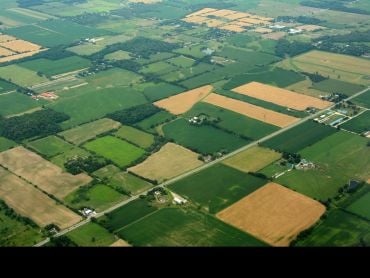
Expert Comment: Why Veganuary: The environmental benefits of a low and no meat diet
Dr Mike Clark, Director of the Food Programme at the Oxford Smith School, discusses the environmental impacts of eating meat, the key research questions we still need to answer, and what individuals can do today.
 Dr Mike Clark.
Dr Mike Clark.
Food systems are major sources of environmental harm and poor health. They emit a third of global greenhouse gas emissions (GHG), are the leading source of biodiversity loss, and occupy almost half of Earth’s land surface. At the same time, dietary patterns are the world’s largest source of poor health, with one recent study showing more deaths attributed to obesity than smoking in the UK. Without rapid, ambitious global action, these impacts will only worsen and prevent achieving urgent targets on climate, biodiversity, and human health.
This introduces a complex triple challenge: how to fix food systems in a way that supports environmental sustainability, human health, and other aspects of human wellbeing?
A key part of this will be to support transitions to diets that are simultaneously healthy and environmentally sustainable. In the UK and other high-income countries, this typically means a transition to diets that contain smaller quantities of animal-based foods and are mostly plant-based. One recent analysis, for instance, found that transitioning to lower meat diets in the UK (defined as <30g meat per day – roughly the weight of a slice of bread) would be the climate equivalent of taking 8 million cars off the road (in addition to other environmental benefits such as improving air quality).
If a dietary and agricultural transition to healthy and sustainable diets were to happen, some sectors might benefit while others would find the transition more difficult. Identifying the positive and negative impacts in this transition will be key.
Another analysis, focusing on the global scale, indicated that removing livestock agriculture entirely (albeit unrealistic) could sequester 330 – 550 Gt CO2, which is equivalent to 6 – 10 years of GHG emissions from all human activities.
Other analyses that focused on scales ranging from hyper local (a college canteen), to corporations (McDonalds and Burger King), to cities (New York City, Berkely California, others), to countries, to the world, also concluded that transitions to low meat diets in high meat consuming countries would result in large environmental benefits and are needed to meet global environmental targets.
For researchers, what questions need answering on transitioning to low and no meat diets?
(1) How can dietary transitions be motivated throughout the food system – from producers, to processors, to consumers, to restaurants, and so on?
Although the environmental and health benefits of transitioning to lower meat diets in contexts like the UK are clear, there is comparatively little research on how to actually implement these transitions through specific mechanisms such as ecolabelling, agricultural policy, or international trade.
Some of the key questions we need to tackle include:
- What is the role that financial and corporate disclosure mechanisms, such as the Taskforce for Nature-Related Financial Disclosures, can play in transitions to more sustainable food systems?
- Is there a role for government policies such as subsidies or taxes based on a food’s negative impact on the environment, health, or society?
- Can celebrities and other influencers help shift food and agricultural behaviours at scale through social media?
(2) How can we create transitions that are just and equitable?
 Our food systems occupy almost half of Earth’s land surface. Image credit: Imnautre, Getty Images.
Our food systems occupy almost half of Earth’s land surface. Image credit: Imnautre, Getty Images.Let’s take an example of a transition to a lower meat diet in the UK along the lines of the 35% meat reduction target by 2050 supported by the UK Climate Change Committee. Such a transition would reduce meat production, which would affect revenue in the meat sector, which could put livestock producers out of a job. There could be other losses as well: to meat processors, for instance, but also butchers, some restaurants (e.g. steak houses), and also consumers.
However, this transition could also lead to additional gains and unlock large economic potential in the fruit and veg sector; currently only 12% of European adults eat their ‘five a day’ of fruit and veg, with the average person in the UK consuming 3.7 portions in 2018.
Alongside the potential environmental and health benefits, it’s important to consider the economic and cultural impacts of these outcomes including whether these can be appropriately compensated.
(3) What is the capacity of plant-based alternatives to play a role in this transition? Or in other words, can they live up to promises?
Although the environmental and health benefits of transitioning to lower meat diets in contexts like the UK are clear, there is comparatively little research on how to actually implement these transitions through specific mechanisms such as ecolabelling, agricultural policy, or international trade.
Plant-based alternatives to meat, dairy, and eggs (typically made from soy, beans, tofu or mycoprotein) are commonly viewed as a potential mechanism to reduce food-related environmental impacts. Recent research indicates substantial environmental benefits of a transition from meat to plant-based equivalents, assuming that most or all of meat is swapped for a plant-based equivalent.
But a key question remains: will people actually eat this many plant-based alternatives? And if so, are they consumed in the place of their animal-based equivalents, or instead in the place of other foods-fruits, vegetables, legumes, nuts, and so on? If the former occurs, the environmental benefits could be significant. But if plant-based alternatives are consumed in place of other veggie foods, then their environmental benefits will be much smaller (or non-existent).
For individuals – what can we do?
Providing the world’s population with healthy, sustainable, nutritious, affordable, and acceptable diets will require action from all fronts – from governments, corporations, the finance sector, and organisations.
A key first step is to be aware of the environmental impacts of food systems, and a second is to swap meat for other foods. This does not mean eating no meat at all – but rather, reducing meat consumption. Starting with one meal a week, or even replacing half of the ground mince in a recipe with mushrooms and legumes would bring large environmental benefits.
Swapping meats with higher environmental impacts (beef, goat, sheep) for those with lower environmental impacts (poultry, pork) is also an opportunity for positive change, as is reducing food loss and waste (more than a third of global food is wasted, which equates to ~8% of GHG emissions and £60 per month for the average UK family with children).
Ultimately, we need broader systemic change to overcome the challenge of supporting the world’s population with healthy, sustainable, nutritious, affordable, and acceptable diets. This will require action from all fronts – governments, corporations, the finance sector, organisations, and so on – to make the healthy and sustainable choice also the easy choice.
 Expert Comment: Chatbot-driven sexual abuse? The Grok case is just the tip of the iceberg
Expert Comment: Chatbot-driven sexual abuse? The Grok case is just the tip of the iceberg
 New study finds that stopping weight-loss drugs is linked to faster regain than ending diet programmes
New study finds that stopping weight-loss drugs is linked to faster regain than ending diet programmes
 Veganuary student blog
Veganuary student blog
 Oxford Student Sasha Gill brings us vegan cooking made easy
Oxford Student Sasha Gill brings us vegan cooking made easy
 Plant-based foods are good for both health and the environment
Plant-based foods are good for both health and the environment